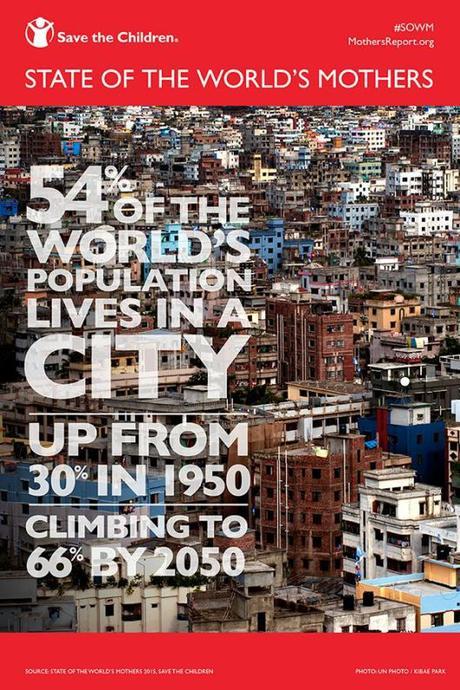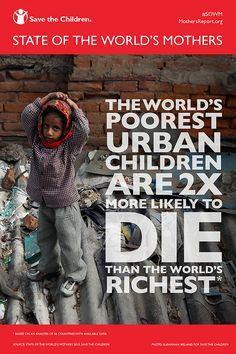 Every year around Mother’s Day a report is released from Save the Children called the “State of the World’s Mothers.” And every year, I write about it.
Every year around Mother’s Day a report is released from Save the Children called the “State of the World’s Mothers.” And every year, I write about it.
Because it is so important to me. If I could spend all day every day with moms and babies, I would. There are so many reasons for this – but partly its because I have five of my own and I learned so much from those younger days. I know what helped and I definitely know what didn’t help. Healthy moms and babies are critical to a healthy world.
In the last 60 plus years, the number of city dwellers in the world has increased by over 20%, so that half the world’s population now lives in the city. While this creates incredible advantages for many of us, there are many others who live in extreme poverty where disease is prevalent, nutrition poor, and violence high. The World Health Organization (WHO) “estimates that nearly a billion people live in urban slums, shantytowns, on sidewalks, under bridges, or along the railroad tracks.” One of the worst places in the world for a mom and a baby to be is in a city slum.

“Every day, 17,000 children die before reaching their fifth birthday. Increasingly, these preventable deaths are occurring in city slums, where overcrowding and poor sanitation exist alongside skyscrapers and shopping malls. Lifesaving health care may be only a stone’s throw away, but the poorest mothers and children often cannot get the care they need.”
- The world, especially the developing world, is becoming urbanized at a breathtaking pace. Virtually all future population growth in developing countries is expected to happen in cities, resulting in a greater share of child deaths taking place in urban areas.
- In developing countries, the urban poor are often as bad as, or worse off than, the average rural family, and for many rural families, moving to the city may result in more – rather than less – hardship
- Few countries have invested sufficiently in the infrastructure and systems, including water and sanitation, which are critical to addressing the basic health needs of the urban poor. More countries need to adopt universal health care as a national policy to help address the unmet needs of the urban poor.
- While great progress has been made in reducing urban under-5 mortality around the world, inequality is worsening in too many cities.
- The poorest children in almost every city face alarmingly high risks of death.
- High child death rates in slums are rooted in disadvantage, deprivation and discrimination.
- Malnutrition is the underlying cause of 45 percent of deaths of children under 5, leading to over 3 million deaths each year, 800,000 of which occur among newborn babies.
- Among capital cities in high-income countries, Washington, DC has the highest infant death risk and great inequality. Save the Children examined infant mortality rates in 25 capital cities of wealthy countries and found that Washington, DC had the highest infant mortality rate at 6.6 deaths per 1,000 live births in 2013. While this rate is an all-time low for the District of Columbia, it is still 3 times the rates found in Tokyo and Stockholm.
Here’s the good news: We know what works! This is huge. Save the Children looked at six cities that, despite significant population growth, have made strides in saving children. Again, from the report:
The cities are: Addis Ababa (Ethiopia), Cairo (Egypt), Manila (Philippines), Kampala (Uganda), Guatemala City (Guatemala) and Phnom Penh (Cambodia). These cities have achieved success through a variety of strategies to extend access to high impact services, strengthen health systems, lower costs, increase health awareness and make care more accessible to the poorest urban residents. 1) Better care for mothers and babies before, during and after childbirth; 2) Increased use of modern contraception to prevent or postpone pregnancy; and 3) Effective strategies to provide free or subsidized quality health services for the poor.
The yearly report always ends with recommendations, and this year is no exception. As a public health nurse, I am always encouraged and discouraged about this report. On the one hand, the statistics are depressing and overwhelming. On the same hand, its all well for a group like Save the Children to talk about what needs to be done, but it is completely different convincing country, state, and city governments that money needs to be given to these efforts.
So where’s the good news? The good news is in places like Heartline Ministries in Haiti. I’ve never been there, but feel like I know two of the midwives who work with Heartline – Beth and Tara – through our email and online interaction. They are two of my “sheros.” Heartline’s mission statement is “Intentionally walking alongside the impoverished men, women, and children of Haiti during their life journeys, meeting critical physical, emotional, financial, educational, and most importantly spiritual needs.” Their maternity center exists to provide prenatal, labor and delivery, and postpartum care to women in Port-au-Prince, Haiti. If you want to know where your money is going to, and want to make a difference, I highly recommend this group. Connect with them on Facebook here.
And the other place I’ve written about before. Shikarpur Christian Hospital has met the needs of moms and babies for years with little recognition and a lot of perseverance. Pakistani and Western staff work hard to give great care to moms and babies in Shikarpur and surrounding areas.
In my public health heart, I know that for real and lasting change to happen, policies are needed at the highest levels. I know that some things are completely impossible without the support of local government. I know in my soul that for real and lasting change, hearts have to change. But while some may say these places are bandaids on a gushing wound, I would say that until we live in a perfect world, thank God for the people who are willing to put on bandaids.
Photo Credit – https://www.pinterest.com/pin/13370130120653125/

